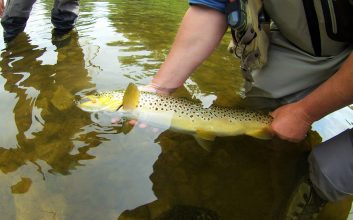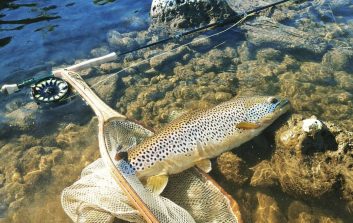If we had our way, everyday on the river would be rich with large mayflies and eager, rising trout but in the real world, trout and trout fishing is just not like that. For those who live near a river and have the luxury of timing hatches or spinner falls, it becomes rather easy to predict what will, or likely will occur and we can pick and choose our times on the water.

Finding large fish on the surface is the what we all wish for, however…
We just grab the right box from our vest and head out with the appropriate rod but for those that have to travel, one must be prepared for all contingencies because the intel that you received yesterday might be out of date in a few hours and what occurred on the river the day before often will not happen the next day.
On most trout systems, it pays to be prepared and being prepared means being versatile and willing to adapt to the conditions. On the Grand River Tail Water, more often than not, what you think will happen, will not and unless you are prepared to make corrections in terms of your presentation, you might just as well go to the pub. One shining example of this is the often unrealistic expectation of intercepting a spinner fall on any given evening. From the middle of May on, spinners will show on just about every stream in the region before and into the dark hours. However, the fish or the bugs don’t always cooperate. If the air temperature drops too much, the spinners may return to the trees and delay their egg laying event. As often as not, the spinners may fall but the fish simply don’t react to them. It could be that there was too much going on sub-surface prior to the spinner fall and the fish were simply full or it could just be that the trout aren’t into it. Anyone who looks for spinners or an emergence for that matter, will tell you they have scratched their head enough times wondering ‘Why aren’t they up and working?’. Who knows? What we do know though, is that even during periods of low activity on or near the surface, trout will still continue to feed, albeit at a less frenzied pace. So what do you do?
If I don’t see fish on the surface, my default plan is to drift a nymph deep and slow as even during these periods, odds are good that you can find a fish or two via that method. If that does do the trick though and usually before I abandon a pool or run, I’ll fire a big, aggressive streamer through it. Trout are predatory and territorial and not unlike bass or pike in a situation like this. A properly presented streamer to even the most satisfied fish can and often does produce a take even if it is simply out of aggression.
So how does one solve the problem of making quick changes without a good deal of muss and fuss? The simplest way is to carry two rods; one geared up for a dry fly and one rigged for a streamer or nymph rig.

Big Streamer take Big Trout regularly!
It is a good practice to carry a leader wallet and have a couple or more sinking leaders at the ready in the event that you can’t find your fish on the surface or with nymphs. Loop to loop connections allow for quick changes and the leader wallet allows one to store leaders in a organized fashion.
Not everyone has two rods or even likes to carry two rods so if I was fishing with only one, it would be a 9′ #5 with a 6 weight line. Why a six weight you ask? This is why: Your average trout stream in south/central Ontario is only about 50
or 60 feet at it’s widest. Obviously there are exceptions to this but it will be the case on the majority of streams in the region. Over lining your rod will allow you to nymph effectively at short distance plus carry larger than average streamers. Although you may be a bit less delicate with a dry fly presentation you can mitigate this by lengthening your tippet. (No one rod does everything perfectly but this set up, if you choose to carry only one rod, will work well in all of these situations.)
The old saying, “20% of the anglers take 80% of the fish” is true but the reason for this is that those 20% are not only able to make adaptations in their presentations, they are also more than willing to take the time to react and re-rig in order to be more productive. You can’t use a driver for every shot on a golf course so why use the same presentation day in and day out.
